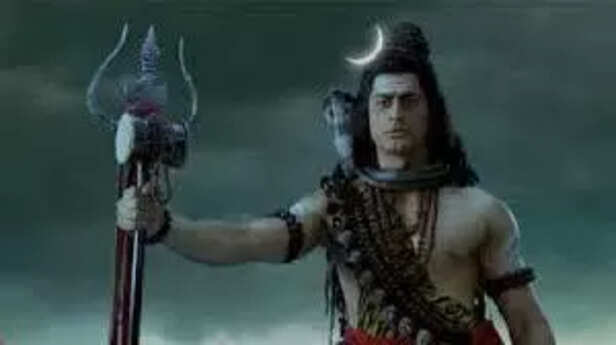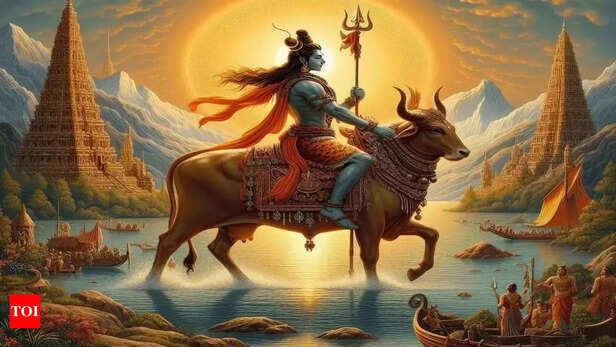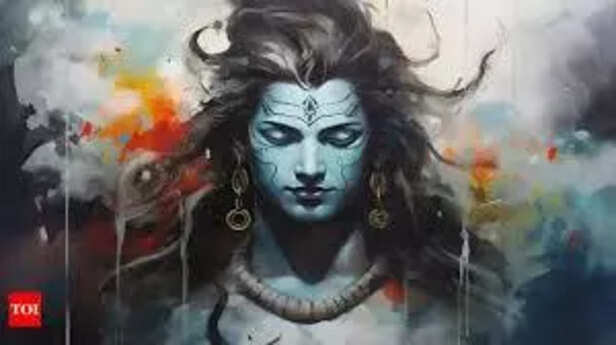Why Did Mahadev’s Wrath Bring Down Daksha’s Empire?
Mili verma | Mar 23, 2025, 20:00 IST
The tale of Mahadev’s wrath upon King Daksha is one of the most dramatic episodes in Hindu mythology. Daksha, blinded by arrogance, insulted Lord Shiva by refusing to invite him to a grand yajna. जटा टवी गलज्जल प्रवाह पावित स्थले ।गलेऽवलम्ब्य लम्बितां भुजंग तुंग मालिकाम् ॥
The tale of Mahadev’s wrath upon King Daksha is one of the most dramatic episodes in Hindu mythology. Daksha, blinded by arrogance, insulted Lord Shiva by refusing to invite him to a grand yajna. His daughter, Sati, unable to bear the insult, immolated herself in protest. Enraged, Shiva unleashed his fury, summoning Virabhadra, who destroyed the yajna and decimated Daksha’s empire. This story serves as a powerful lesson on ego, devotion, and the consequences of disrespecting divine forces. As the Shiva Tandava Stotram states:
जटा टवी गलज्जल प्रवाह पावित स्थले ।
गलेऽवलम्ब्य लम्बितां भुजंग तुंग मालिकाम् ॥
(With matted hair, the water from the holy Ganga flows and purifies Shiva; he adorns his neck with a garland of great snakes, signifying his fearlessness.)
Why Did Mahadev’s Wrath Bring Down Daksha’s Empire?

The Arrogance of King Daksha:
King Daksha, one of the Prajapatis and a powerful ruler, was known for his rigid beliefs and pride. He was the father of Goddess Sati, who was deeply devoted to Lord Shiva. However, Daksha harbored immense disdain for Shiva, whom he considered unworthy due to his ascetic lifestyle, unconventional ways, and disregard for societal norms.
When Daksha organized a grand yajna (sacrificial ritual), he deliberately excluded Shiva from the invitation. This act was a public declaration of his contempt. Many deities, sages, and celestial beings attended the yajna, but the absence of Shiva created an imbalance in the divine order.
Despite not being invited, Sati wished to attend the yajna and seek her father’s blessings. Shiva warned her against going, but her love for her family overpowered his advice. Upon reaching the yajna, she was met with humiliation. Daksha openly insulted Shiva, calling him a mendicant and unfit for divine respect.
Unable to bear this dishonor, Sati declared that she no longer wished to be associated with a father who disrespected her husband. She invoked her inner fire and immolated herself, leaving the gathering in shock.
News of Sati’s self-sacrifice reached Shiva, plunging him into inconsolable grief. His sorrow soon turned into fury, and in his rage, he created Virabhadra, a fierce manifestation of his wrath, and Bhadrakali, a powerful goddess. Shiva ordered Virabhadra to destroy the yajna and punish Daksha.
Virabhadra, accompanied by a fearsome army of ganas (Shiva’s attendants), stormed into Daksha’s sacrificial hall. The devas, rishis, and celestial beings present were unable to stop him. Virabhadra wreaked havoc—he desecrated the yajna, vanquished Daksha’s guards, and struck fear into the hearts of all present.
In a climactic moment, Virabhadra beheaded King Daksha, marking the ultimate consequence of his arrogance. The yajna, which was meant to be a grand divine offering, lay in ruins.
Divine Reconciliation: Shiva’s Forgiveness

After the destruction, the devas and rishis pleaded with Lord Shiva to calm his wrath. Shiva, embodying both destruction and compassion, eventually relented. He restored Daksha’s life by placing the head of a goat on his body. This transformation symbolized the humbling of Daksha’s pride. The yajna was then completed with proper rituals, and the devas paid their respects to Shiva.
Daksha, now reformed, bowed before Shiva, realizing his folly and seeking forgiveness. This episode teaches that arrogance and disrespect toward divinity lead to downfall, but true repentance brings redemption.
The destruction of Daksha’s empire by Shiva’s wrath is a deeply symbolic narrative. It conveys multiple lessons:
Shlokas That Depict This Story

The Shiva Purana and Skanda Purana narrate the incident in detail. One of the powerful mantras related to Shiva’s cosmic dance of destruction and power is:
ॐ नमः शिवाय |
Om Namah Shivaya
(A mantra signifying surrender to Lord Shiva, acknowledging his supreme power.) Another relevant shloka is from the Shiva Tandava Stotram, which describes Shiva’s cosmic dance of destruction:
जटा टवी गलज्जल प्रवाह पावित स्थले ।
गलेऽवलम्ब्य लम्बितां भुजंग तुंग मालिकाम् ॥
(With matted hair, the water from the holy Ganga flows and purifies Shiva; he adorns his neck with a garland of great snakes, signifying his fearlessness.)
This story remains one of the most powerful testaments to the role of divine justice in the cosmic order. It reminds us that arrogance, no matter how mighty, cannot stand before true devotion and righteousness.
Explore the latest trends and tips in Health & Fitness, Travel, Life Hacks, Fashion & Beauty, and Relationships at Times Life.
जटा टवी गलज्जल प्रवाह पावित स्थले ।
गलेऽवलम्ब्य लम्बितां भुजंग तुंग मालिकाम् ॥
(With matted hair, the water from the holy Ganga flows and purifies Shiva; he adorns his neck with a garland of great snakes, signifying his fearlessness.)
Why Did Mahadev’s Wrath Bring Down Daksha’s Empire?

Lord Shiv & King Daksha
The Arrogance of King Daksha:
King Daksha, one of the Prajapatis and a powerful ruler, was known for his rigid beliefs and pride. He was the father of Goddess Sati, who was deeply devoted to Lord Shiva. However, Daksha harbored immense disdain for Shiva, whom he considered unworthy due to his ascetic lifestyle, unconventional ways, and disregard for societal norms.
When Daksha organized a grand yajna (sacrificial ritual), he deliberately excluded Shiva from the invitation. This act was a public declaration of his contempt. Many deities, sages, and celestial beings attended the yajna, but the absence of Shiva created an imbalance in the divine order.
Sati’s Sacrifice and Shiva’s Wrath
Unable to bear this dishonor, Sati declared that she no longer wished to be associated with a father who disrespected her husband. She invoked her inner fire and immolated herself, leaving the gathering in shock.
News of Sati’s self-sacrifice reached Shiva, plunging him into inconsolable grief. His sorrow soon turned into fury, and in his rage, he created Virabhadra, a fierce manifestation of his wrath, and Bhadrakali, a powerful goddess. Shiva ordered Virabhadra to destroy the yajna and punish Daksha.
Virabhadra’s Rampage and the Destruction of Daksha’s Yajna
In a climactic moment, Virabhadra beheaded King Daksha, marking the ultimate consequence of his arrogance. The yajna, which was meant to be a grand divine offering, lay in ruins.
Divine Reconciliation: Shiva’s Forgiveness

Virabadra
After the destruction, the devas and rishis pleaded with Lord Shiva to calm his wrath. Shiva, embodying both destruction and compassion, eventually relented. He restored Daksha’s life by placing the head of a goat on his body. This transformation symbolized the humbling of Daksha’s pride. The yajna was then completed with proper rituals, and the devas paid their respects to Shiva.
Daksha, now reformed, bowed before Shiva, realizing his folly and seeking forgiveness. This episode teaches that arrogance and disrespect toward divinity lead to downfall, but true repentance brings redemption.
The Spiritual Significance of the Story
- Ego Leads to Destruction: Daksha’s arrogance made him blind to divine wisdom, leading to his downfall.
- Devotion Transcends Social Norms: Sati’s love for Shiva was pure and unwavering, contrasting with Daksha’s superficial judgments.
- Divine Wrath Is Justified: Shiva’s fury was not out of malice but a response to injustice and insult to devotion.
- Balance Between Creation and Destruction: The cycle of creation, destruction, and restoration is an eternal principle of the universe.
- The Power of Repentance: Even after his downfall, Daksha’s redemption signifies that humility and realization can lead to forgiveness and renewal.
Shlokas That Depict This Story

Shiva Purana
The Shiva Purana and Skanda Purana narrate the incident in detail. One of the powerful mantras related to Shiva’s cosmic dance of destruction and power is:
ॐ नमः शिवाय |
Om Namah Shivaya
(A mantra signifying surrender to Lord Shiva, acknowledging his supreme power.) Another relevant shloka is from the Shiva Tandava Stotram, which describes Shiva’s cosmic dance of destruction:
जटा टवी गलज्जल प्रवाह पावित स्थले ।
गलेऽवलम्ब्य लम्बितां भुजंग तुंग मालिकाम् ॥
(With matted hair, the water from the holy Ganga flows and purifies Shiva; he adorns his neck with a garland of great snakes, signifying his fearlessness.)
This story remains one of the most powerful testaments to the role of divine justice in the cosmic order. It reminds us that arrogance, no matter how mighty, cannot stand before true devotion and righteousness.
Explore the latest trends and tips in Health & Fitness, Travel, Life Hacks, Fashion & Beauty, and Relationships at Times Life.
